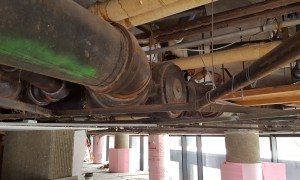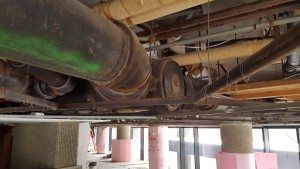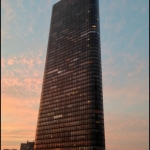Why All the Water Shutdowns? Part 1
September 9, 2015
Maintaining a skyscraper and all its parts and pieces can present quite a challenge – especially when it’s not just any building but one that a thousand plus people call home. There are miles of plumbing lines in our building, and a lot of time, patience and resources are needed to properly maintain them.
The plumbing project being completed now – overhead in Park Tower’s lobby, party and weight rooms – is one all high-rises need eventually, but also one of the most disruptive. The aggravation and interruption to day-to-day routine is made worse by the almost daily loss of water service and the “industrial makeover” appearance of the lobby.
Over these past several years, we have been replacing the risers that move hot water up into residential units, a labor-intensive and patience-exhausting job if there ever was one. And as we open bathroom and kitchen walls to replace the risers, we also replace the branch lines that connect them with sinks, tubs and toilets except where, due to building requirements, those new copper branch lines are already in place due to earlier remodeling.
Disruptive but necessary, this hot water riser and branch line replacement will continue for several more years after which we will turn our attention to the HVAC (heating/cooling) risers.
About a year ago we learned of a situation that caused us to put off the scheduled hot water riser replacements for the time needed to address a serious problem with the main lines, or loops, that connect up with risers.
To back up a bit, the building gets its water from – and moves its waste to – city facilities. Water coming into the building is pumped up to two huge water supply loops, one cold, the other hot. Waste about to leave the building drains down from residences into an equally large drain loop.
All three loops are installed in the crawl space above lobby, party and weight room ceilings, filling the entire triangular expanse of the building. It is these loops, then, that connect with the risers, which ascend vertically from the 3rd to the 55th floors.
Waste from sinks and toilets drains into branch lines, which move it to drain risers, where it falls into a single drain loop and finally empties into the city’s system. Fresh hot and cold water move in the other direction, through their own risers.
Two additional points: First, only hot water risers are being replaced; the cold water risers are okay for the foreseeable future.
Second, between the many risers – 34 in all – and their three loops are rotary valves that act as on/off switches allowing a greater measure of control.
What caught our attention early on, while replacing risers, was that those supply and waste loops were nearing the end of their useful lives. The loops were so fragile that just touching them could compromise their integrity and result in a leak. And the valves were functionally obsolete – which we learned in early August when we attempted unsuccessfully to use them for more targeted water shutdowns.
When these conditions were discovered, the Board, our budget and finance committee, and management began laying the foundation to shift focus for one year from riser replacements to the project we now expect to complete in October.
During the two years that follow, we will return to riser replacement, doing the next six most in need. Relying on an ultrasound study performed in 2009 by McGuire Engineering, we have been replacing them in the order of their condition, worst ones first.
We are also upgrading the technology that controls this network of plumbing. While not as glamourous as some of our recent lighting and electrical upgrades — and not expected to save us a radical sum of money like, say, the recent upgrades to our boilers – the new valves and mechanisms are expected to save water, time, disruption and money in the future.
In the next issue of Tower Talk, I will explain some of the things we have done with this project which will benefit the building and association in the long term.









